The University of Chicago Press, Chicago 60637
The University of Chicago Press, Ltd., London
1987 by The University of Chicago
All rights reserved. Published 1987
Paperback edition 1990
Printed in the United States of America
14 13 12 11 10 09 08 14 13 12 11
ISBN 978-0-226-47101-3 (e-book)
Library of Congress Cataloging-in-Publication Data
Lakoff, George.
Women, fire, and dangerous things.
Bibliography: p.
Includes index.
1. Psycholinguistics. 2. Categorization (Psychology). 3. Cognition. 4. Thought and thinking. 5. Reason. I. Title.
P37.L344 1986 401.9 86-19136
ISBN 0-226-46804-6 (paper)
 The paper used in this publication meets the minimum requirements of the American National Standard for Information SciencesPermanence of Paper for Printed Library Materials, ANSI Z39.48-1992
The paper used in this publication meets the minimum requirements of the American National Standard for Information SciencesPermanence of Paper for Printed Library Materials, ANSI Z39.48-1992
George Lakoff
Women, Fire, and Dangerous Things
What Categories Reveal about the Mind

The University of Chicago Press
Chicago and London
To Claudia
Contents
Acknowledgments
This book is very much a product of the incredibly stimulating and open intellectual environment of the University of California at Berkeley, where I have been privileged to work for the past thirteen years. I could not have done this work anywhere else. Much of what I have learned during this period has come through interactions with remarkable colleagues, especially Brent Berlin, Hubert Dreyfus, Charles Fillmore, Jim Greeno, Paul Kay, Eleanor Rosch, Dan Slobin, Eve Sweetser, Len Talmy, Robert Wilensky, and Lotfi Zadeh. I have also been blessed with remarkable students, especially Claudia Brugman, Pamela Downing, Michele Emanatian, Rob MacLaury, Chad McDaniel, and Jeanne van Oosten, and much of this book reflects what I have learned from them. was done jointly with Zoltn Kvecses, whose stay at Berkeley during the 198283 academic year was funded by the American Council of Learned Societies. Without their insight, their diligence, and their generosity, this book would be much the poorer.
I have also been fortunate to be part of a widespread network of cognitive scientists whose research complements my own and who have been unsparingly generous in keeping me informed of their research and in commenting on mine:
Alton L. Becker, at the University of Michigan
Dwight Bolinger, emeritus from Harvard, now living in Palo Alto
Gilles Fauconnier, of the University of Paris at St. Denis
Dedre Gentner, at the University of Illinois at Urbana
Mark Johnson, at Southern Illinois University
Zoltn Kvecses, at Eotvos Lrnd University in Budapest
Ronald Langacker, at the University of California at San Diego
Susan Lindner, in Palo Alto
James D. McCawley, at the University of Chicago
David McNeill, at the University of Chicago
Hilary Putnam, at Harvard University
Naomi Quinn, at Duke University
John Robert Ross, at the Massachusetts Institute of Technology
David Zubin, at the State University of New York at Buffalo
I would also like to thank R. M. W. Dixon and Annette Schmidt of the Australian National University for providing me with a lengthy discussion of their research on Dyirbal categorization, as well as Pamela Downing and Haruo Aoki, who provided me with details about Japanese classifiers. Mark Johnson and Hilary Putnam have been extremely helpful in discussing philosophical issues, especially their recent work. The philosophical views put forth here have been worked out in collaboration with Johnson over many years. Robert Solovay and Saunders Mac Lane provided enormously useful discussions of the foundations of mathematics. Extensive comments on drafts of the manuscript have been provided by Jay Atlas, Lawrence Barsalou, Claudia Brugman, Michele Emanatian, Charles Fillmore, Jim Greeno, Mark Johnson, Paul Kay, Zoltn Kvecses, Robert McCauley, James D. McCawley, Carolyn Mervis, Ulric Neisser, Eleanor Rosch, Edward Smith, Robert Wilensky. Sustenance of extraordinary quality was provided by Cafe Fanny in Berkeley.
This research would not have been possible without grants from the National Science Foundation (grant no. BNS-8310445), the Sloan Foundation, and the Committee on Research of the University of California at Berkeley. I would especially like to thank Paul Chapin at NSF and Eric Wanner at Sloan.
Large projects like this cannot be completed without enormous sacrifices on the home front. Claudia Brugman and Andy Lakoff have put up with my unavailability for longer than I would like to think. I thank them for their patience and perseverance with all my heart.
Berkeley, California July, 1985
Preface
Cognitive science is a new field that brings together what is known about the mind from many academic disciplines: psychology, linguistics, anthropology, philosophy, and computer science. It seeks detailed answers to such questions as: What is reason? How do we make sense of our experience? What is a conceptual system and how is it organized? Do all people use the same conceptual system? If so, what is that system? If not, exactly what is there that is common to the way all human beings think? The questions arent new, but some recent answers are.
This book is about the traditional answers to these questions and about recent research that suggests new answers. On the traditional view, reason is abstract and disembodied. On the new view, reason has a bodily basis. The traditional view sees reason as literal, as primarily about propositions that can be objectively either true or false. The new view takes imaginative aspects of reasonmetaphor, metonymy, and mental imageryas central to reason, rather than as a peripheral and inconsequential adjunct to the literal.
The traditional account claims that the capacity for meaningful thought and for reason is abstract and not necessarily embodied in any organism. Thus, meaningful concepts and rationality are transcendental, in the sense that they transcend, or go beyond, the physical limitations of any organism. Meaningful concepts and abstract reason may happen to be embodied in human beings, or in machines, or in other organismsbut they exist abstractly, independent of any particular embodiment. In the new view, meaning is a matter of what is meaningful to thinking, functioning beings. The nature of the thinking organism and the way it functions in its environment are of central concern to the study of reason.
Both views take categorization as the main way that we make sense of experience. Categories on the traditional view are characterized solely by the properties shared by their members. That is, they are characterized (a) independently of the bodily nature of the beings doing the categorizing and (b) literally, with no imaginative mechanisms (metaphor, metonymy, and imagery) entering into the nature of categories. In the new view, our bodily experience and the way we use imaginative mechanisms are central to how we construct categories to make sense of experience.
Cognitive science is now in transition. The traditional view is hanging on, although the new view is beginning to take hold. Categorization is a central issue. The traditional view is tied to the classical theory that categories are defined in terms of common properties of their members. But a wealth of new data on categorization appears to contradict the traditional view of categories. In its place there is a new view of categories, what Eleanor Rosch has termed
Next page
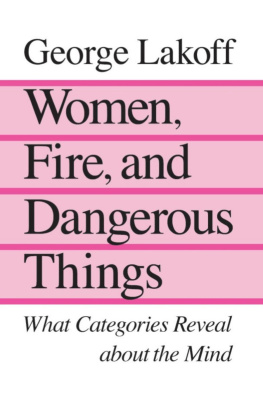

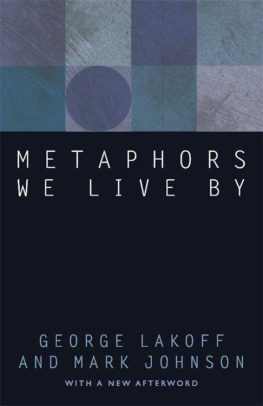

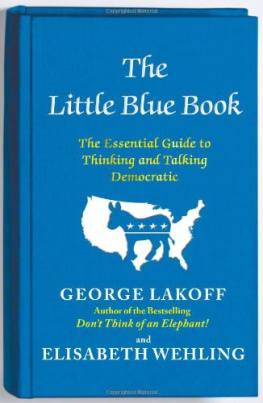
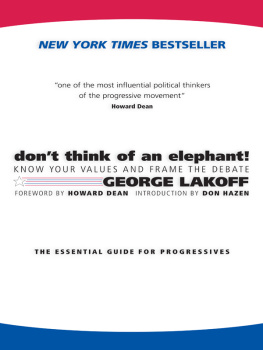


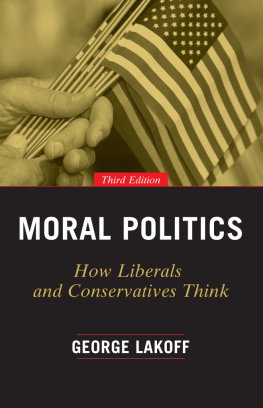

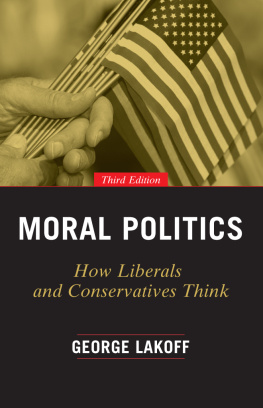

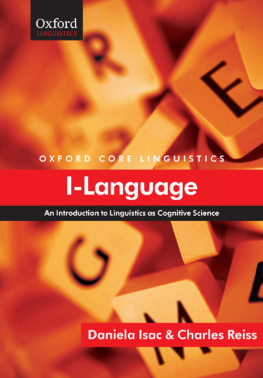
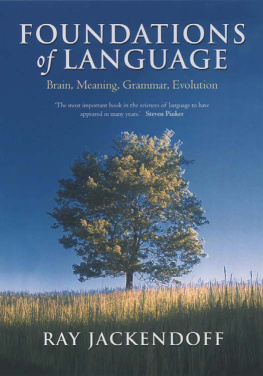
 The paper used in this publication meets the minimum requirements of the American National Standard for Information SciencesPermanence of Paper for Printed Library Materials, ANSI Z39.48-1992
The paper used in this publication meets the minimum requirements of the American National Standard for Information SciencesPermanence of Paper for Printed Library Materials, ANSI Z39.48-1992